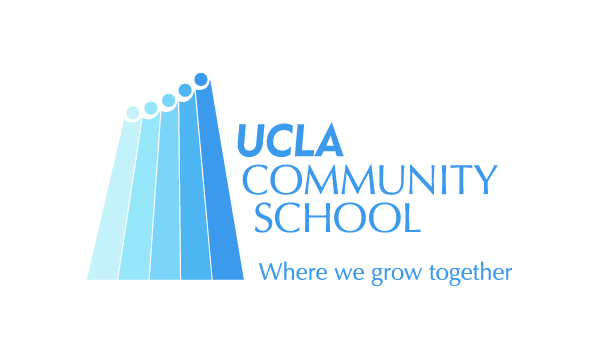
2019-20 Annual Report: The Power of Community
September 29, 2020
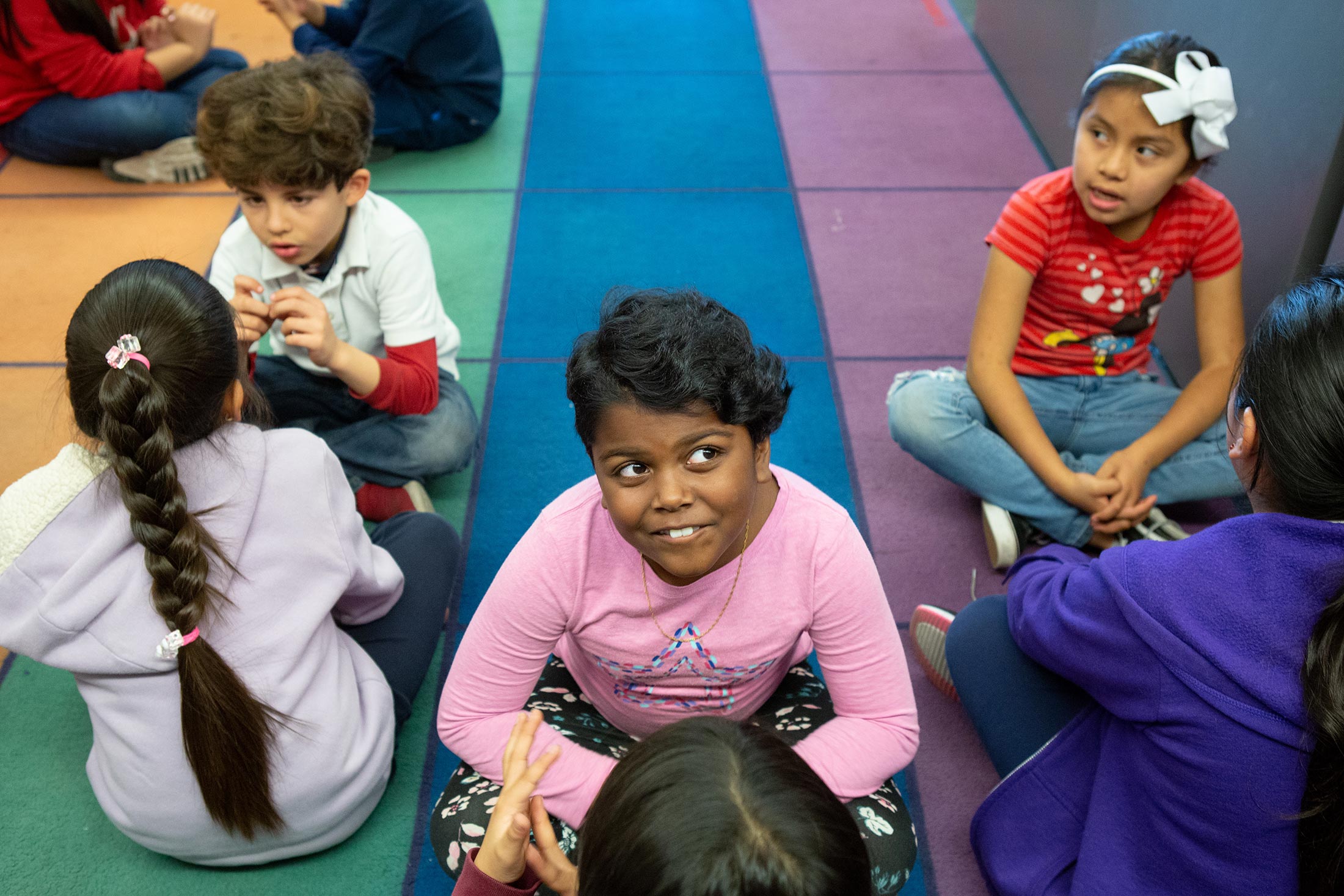
Introduction
Founded in 2009, the UCLA Community School (UCLA-CS) is a unique partnership among the Los Angeles Unified School District (LAUSD), the University of California, Los Angeles (UCLA), and the local community. As partners, we are engaging together to strengthen public education for all students. This year’s annual report focuses on the school’s strong sense of community and the collective agency of educators, students, families, and UCLA partners in response to the pandemic and Spring 2020 school closure. Alongside our annual demographics and dashboard indicators, we share a set of core practice narratives that bring to life the power of community to support the well-being and education of its members.
Following a brief overview of the school context, history, and demographics in Part One, Part Two describes the core practices that enliven the school’s vision and shares narratives that illustrate how these practices create a strong school community. Part Three turns to quantitative indicators of the school’s progress over the past 11 years, framed as four dashboards—each focused on one of the school’s core competencies. Part Four focuses on adult learning and development—the conditions that shape teaching and learning for students. This section includes two dashboards, one that tracks professional working conditions for teachers and the other that captures the scope of UCLA’s engagement as a teaching school. The final section reflects on the school’s role in leveraging system-wide change, including participation in larger reform movements and a sample of findings from its portfolio of research studies.
Part One: History, Context, and Community
The UCLA Community School (UCLA-CS) is an autonomous K-12 Pilot School in one of the state’s most densely populated immigrant neighborhoods in central Los Angeles. Located in Koreatown on the former site of the Ambassador Hotel, the school has a rich cultural and historic legacy, including the tragic assassination of Robert F. Kennedy in 1968. UCLA-CS belongs to the progressive tradition of university-based lab schools (such as UCLA Lab School), and the national community schools movement. This tradition honors the role of students in constructing their own learning and developing their knowledge, skills, and passions—facilitated by caring adults, other students, and engaging educational experiences within and beyond the classroom. It also honors the role public education plays in our democracy and seeks to instill in students a commitment to justice and the common good.
There are no criteria for admission to UCLA-CS beyond residency in the adjoining neighborhood. Local families choose among six autonomous LAUSD Pilot Schools at the RFK Complex: UCLA-CS, Ambassador School of Global Education (K-5), Ambassador School of Global Leadership (6-12), New Open World Academy (K-12), Los Angeles High School of the Arts (9-12), and School of Visual Arts and Humanities (9-12). In 2010, these six schools formed the district’s first complex of “wall to wall” Pilot schools. There are now 47 LAUSD Pilot Schools, an in-district and union reform created a decade ago, in 2007, to support innovation by giving schools autonomy over budget, staffing, governance, curriculum/assessment, and the school calendar in exchange for heightened accountability.
As a co-located school, UCLA-CS shares facilities and resources, including maintenance personnel, with the other five schools. The shared facilities include: cafeterias, the historic Cocoanut Grove Theater, Paul Schrade Library, gymnasiums, swimming pool, athletic fields, gardens, and several public art installations, including two murals by UCLA professor Judith Baca that anchor the historic library. In 2016, 28 new murals were installed as part of a larger public art campaign. In the mural (below), Mexico City painter and street artist Curiot (Favio Martinez) creates vibrant mythical beasts blending human and animal forms while alluding to a number of Mexican traditions including tribal art, the Day of the Dead, and various geometric designs. The other murals are diverse in their representations, including students, civil rights leaders, political issues, children, artists, animals, messages, abstractions, and more.
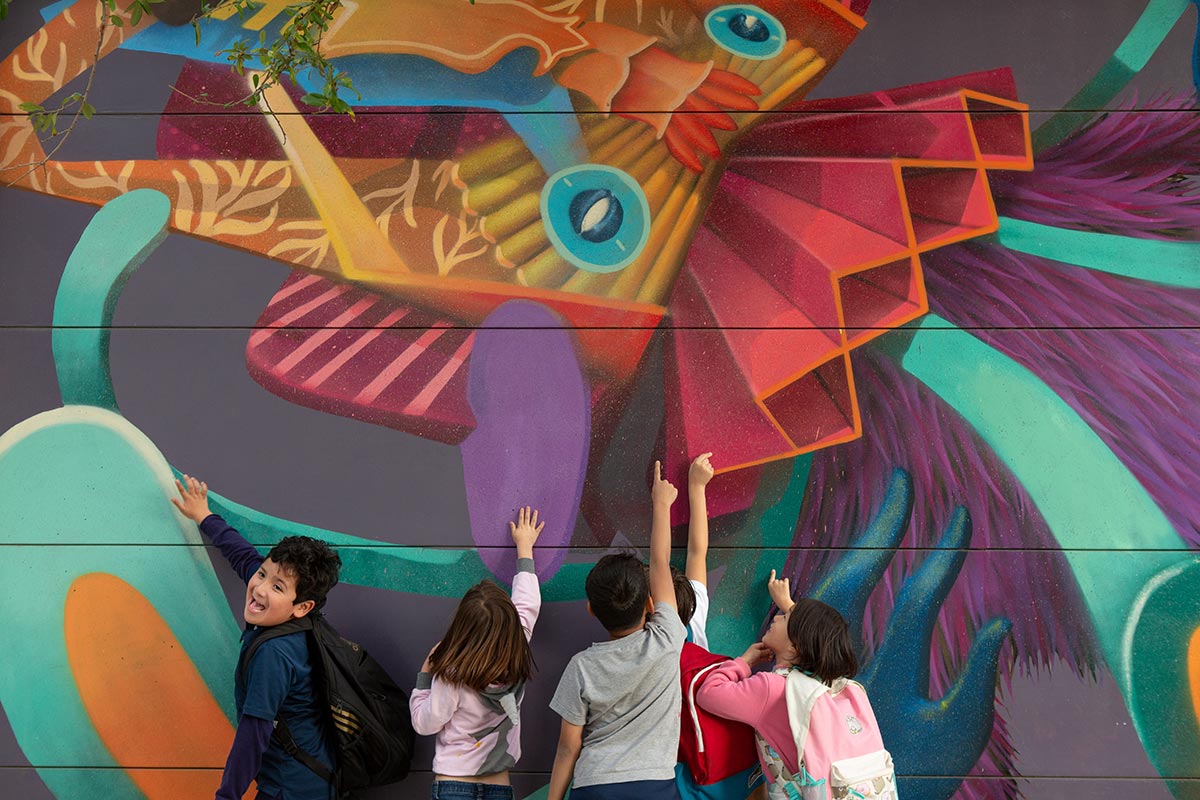
Students
From 2009 to 2010, students entered the UCLA Community School in Kindergarten through 11th grade from more than 60 feeder schools throughout Los Angeles—most returning to a neighborhood school after years of being bussed across the city. By 2011-12, the school had reached its K-12 capacity. In 2015, the Kindergarten Readiness Act allowed the school to introduce one Transitional Kindergarten (TK) class for children with fall birthdays. There are approximately 60 students per grade level from Kindergarten through 8th grade. In 9th grade, a new cohort of approximately 50 students join these “homegrown” students, a design shaped by the district’s funding model for high schools. The Class of 2022 will be the first K-12 cohort of students to graduate. Many of the students who graduated online in June 2020 entered as 2nd graders.
In 2019-20, the school maintained its enrollment target of approximately 1,000 students (985), notable given the district’s declining enrollment. As Figure 1 indicates, the student population is Latino (83%), Asian American or Pacific Islander (8%), Filipino (5%), African American (3%), and White (1%) which contrasts with both the district and state demographics. The school enrolls more transient and immigrant students than the district as a whole. About two-thirds of the residents in the school’s neighborhood are foreign-born, primarily from Mexico, Central America, and Korea—among the highest percentage of immigrants in Los Angeles.

Compared with the district and state, a higher percentage of UCLA-CS students in 2019-20 were socioeconomically disadvantaged and were classified as English Learners (see Table 1).
Despite these differences and challenges, the school outperforms the district on many measures, as detailed in Part Three.
Adults
In 2019-20, there were 54 full-time teachers, three administrators, and many support staff, including counselors, office clerks, program specialists, parent representatives, and aides. In addition, UCLA faculty, staff, and students contributed more than 16,040 hours at the school in 2019-20, serving as tutors, apprentice teachers, service learning interns, arts educators, researchers, instructional coaches, members of the Shared Governing Council, and more. All of these adults help make the school a vibrant, adult-rich learning environment as well as a vital UCLA site for teaching, research, and service.

The teaching faculty is diverse and accomplished. Figure 2 summarizes teacher ethnicity data for the school in 2019-20 based on self-reports, and the district and state in 2018-19 (most recent data available), demonstrating that UCLA Community School is more diverse than the LAUSD and state workforce. Most of the faculty is bilingual (88%) or trilingual (9%), bringing a wealth of cultural knowledge to their work with students and families. Overall, about half of the faculty are UCLA alumni and 62% hold Master’s degrees—32 percentage points higher than the state.
 In September, the school mourned the loss of longstanding community school educator, Ms. Susan Hee Jung Uh. A beloved special education and music teacher, Susan immigrated from Korea at the age of 13. She attended the University of California, Santa Barbara, began her teaching career at Fremont High School, and joined the school in 2011. In a community circle the day after her passing, faculty and staff reflected on Susan’s kindness, dedication to the school, and love for her students.
In September, the school mourned the loss of longstanding community school educator, Ms. Susan Hee Jung Uh. A beloved special education and music teacher, Susan immigrated from Korea at the age of 13. She attended the University of California, Santa Barbara, began her teaching career at Fremont High School, and joined the school in 2011. In a community circle the day after her passing, faculty and staff reflected on Susan’s kindness, dedication to the school, and love for her students.
Part Four includes more details about the professionals working at the school as well as the quality of the school as a stable and democratic workplace.
Part Two: School Vision and Core Practices
UCLA Community School is a community-based, learner-centered, university-partnered school—a school where many different people come together, driven by the nation’s long legacy of common schooling, to create a place of learning for the next generation. The school expects students to enter the adult world as confident and capable human beings, prepared to succeed in college, pursue meaningful careers, and participate in our democracy. To realize this vision, all facets of the school are focused on achieving the following four core competencies set in motion by a design team in 2007.

Each year, these competencies drive inquiry and improvement for all members of the school community. Preparing all students to be college ready goes far beyond the academic press for mastery (CC2); it involves cultivating interests, passions, and agency (CC1), using more than one language (CC3), and learning how to work with others to advance change (CC4). Keeping all of these competencies front and center also guards against the narrowing of the curriculum and affirms the value of rich and diverse educational experiences.
For our youngest students, these experiences start in a transitional kindergarten class to build a foundation for passionate and active learning. From there, they move through the Lower School in three multi-age Dens, staying with the same teacher and peers for two years. This approach creates a strong, supportive community for children and allows teachers to personalize learning. Building on the language assets of our families, all students participate in a dual language program (Spanish/English or Korean/English) where students receive language and content instruction in two languages. As the transition between the lower grades and high school, the middle school (Division 1) provides a nurturing student-centered learning community. Instruction is cored in 6th grade to enable students to develop close relationships with two content teachers (math/science and humanities). In 2018-19, the school received certification to extend its dual language program past 5th grade, starting with the 6th grade cohort in 2019-20. In 7th and 8th grades, students rotate across core classes and project-based seminars, supported by the same advisor for two years. Division 1 students demonstrate their learning at the end of 8th grade before they culminate to high school.
Our “homegrown” students seamlessly transition to high school and are joined by a new cohort of students who enter from neighboring middle schools, increasing the size of the secondary program to approximately 120 students per grade. All students enroll in a rigorous sequence of college-prep courses that exceed the standards for admission to the University of California/California State University System. The school also partners with Los Angeles City College, as part of the SuperGrad Program, to offer several college-level courses each semester. College classes are available to all students through dual enrollment. Students learn in an eight-period rotating block schedule designed to support the longer time needed for active, inquiry-based learning. In addition to core classes and an advisory period, students explore their interests and passions through an innovative seminar program that culminates in a Senior Internship experience.
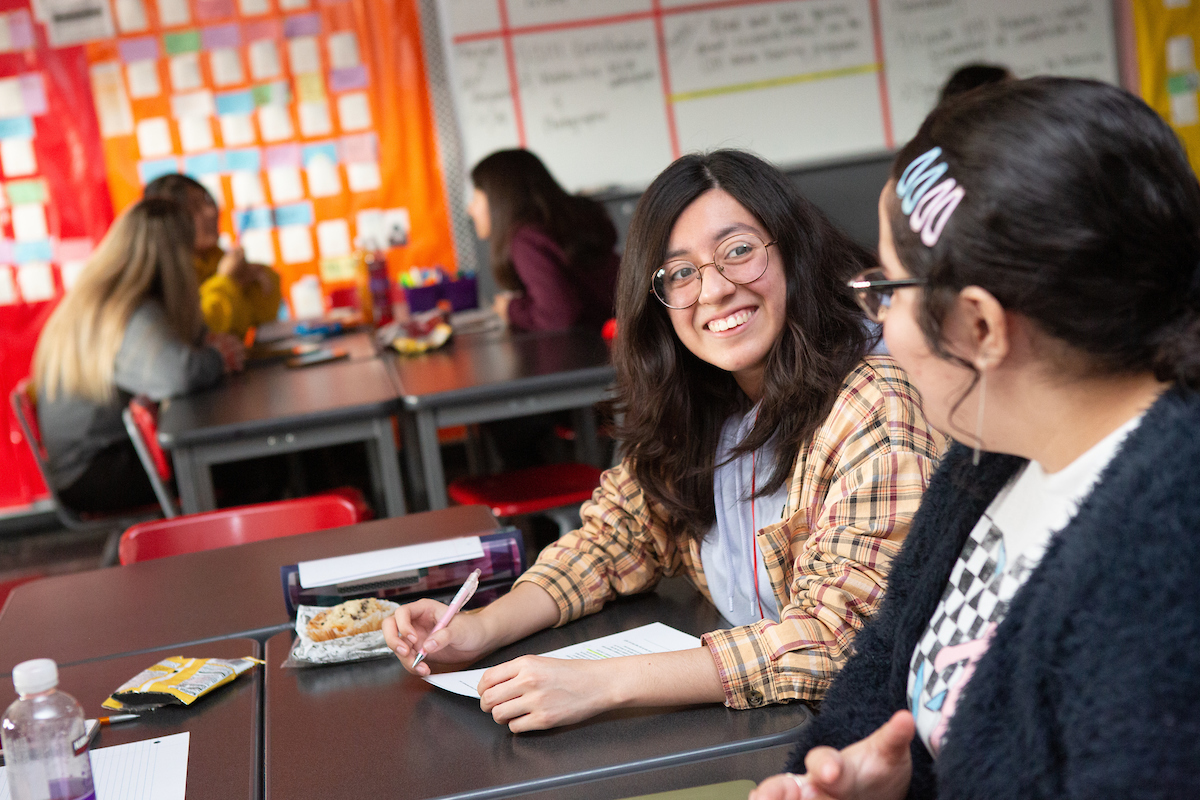
To take stock and strengthen these core practices, the entire school community engaged in self-study in 2018-19, in preparation for a third WASC accreditation cycle and three-day visit in October 2019. The school received another six-year accreditation decision based on a thorough analysis of its progress. The visiting committee recommended that the school continue to develop its multi-tier systems of support, use data to inform planning, and deepen its core instructional programs. Schoolwide strengths identified by the committee included a commitment to the four core competencies, a strong college-going culture, collaborative processes, culturally relevant and student-centered campus, dedication to the whole child, dual-language program, and the school’s inclusive environment.
The following core practice narratives illustrate the strengths identified by the WASC visiting committee, each highlighting a defining feature of powerful learning communities. The first narrative focuses on practices that support compassion, empathy and identity development for immigrant students. The second is a story about teaching students to be active and engaged members of their communities. And the final two narrative capture the school’s response to the school closure in March 2020, highlighting practices that nurture and sustain relationships in times of crisis.
Core Practice Narrative #1: A Compassionate Community

Robert F. Kennedy’s longstanding friendship with Cesar Chavez, Dolores Huerta, and other civil rights leaders is memorialized in the school’s library in a public art mural by Judith Baca entitled, “Seeing Through Other’s Eyes.” This social justice legacy and ethic of compassion has created a strong sense of belonging and trust in the school’s immigrant-rich community. As a sanctuary school for immigrants, UCLA Community School has put in place a wide-ranging set of institutional structures and policies designed to honor, support and celebrate immigrants. Now in its third year of operation, the UCLA Immigrant Family Legal Clinic provides direct legal representation, consultations, and community education. A sanctuary school protocol, developed by student activists, provides resources and protects families. And there are many spaces and events, such as the schoolwide Dia de los Muertos celebration, that honor the cultures and experiences of families.
Inside the classroom, bilingual teaching practices are designed to honor and develop students’ home languages and their immigrant identity. To inform their practice, a group of teachers have worked with Reimagining Migration, a project based at UCLA and Harvard University, that aims “to ensure that all young people grow up understanding migration as a fundamental characteristic of the human condition, in order to develop the knowledge, empathy and mindsets that sustain inclusive and welcoming communities.”
In the fall of 2019, teachers planned an instructional unit to help newcomer students develop their English language skills while also honoring and sharing the rich stories of hope and struggle that brought them to this country. The high school students created childrens’ books about their migration stories and shared them with fourth and fifth grade students. The younger students were thoroughly engaged in the storytelling and offered supportive and critical feedback to the older students. As a span school, teachers routinely bring together students at different stages of their development to share their learning and their stories–in community.
students develop their English language skills while also honoring and sharing the rich stories of hope and struggle that brought them to this country. The high school students created childrens’ books about their migration stories and shared them with fourth and fifth grade students. The younger students were thoroughly engaged in the storytelling and offered supportive and critical feedback to the older students. As a span school, teachers routinely bring together students at different stages of their development to share their learning and their stories–in community.
Core Practice Narrative #2: An Engaged Community
Students across the globe were inspired this year by Greta Thunberg, Xiuhtezcatl Martinez, Isra Hirsi, and other teen climate activists. Middle school science teacher Janice Chow seized the moment to engage her 8th grade students in the fight for environmental justice. Students learned about the effects of climate change and developed mitigation plans for government and industry to reduce emissions. Student plans included a greater investment in biofuels, solar power, as well as improved transportation and building efficiency. Students shared these plans in letters to their legislators–expressing concerns about the rise of greenhouse gases. As one student wrote, “Climate change has already damaged so much of our world…like causing more wildfires and killing Australian animals… I am writing this because I have a little brother and I don’t want him to live in a world of destruction.” Another student shared, “I am just asking that you give us teenagers the future that we deserve.”
 On February 20th, 2020 students had an opportunity to present their mitigation plans to Congressman Jimmy Gomez (US Representative for 34th Congressional District). At a local community meeting, students introduced themselves, presented their letters, and asked, “What are you and Congress doing to stop climate change?” Impressed with their environmental activism, Congressman Gomez invited 8th graders to visit the Los Angeles Department of Water and Power’s La Kretz Innovation Campus which is a living lab for new and emerging technologies focused on sustainability.
On February 20th, 2020 students had an opportunity to present their mitigation plans to Congressman Jimmy Gomez (US Representative for 34th Congressional District). At a local community meeting, students introduced themselves, presented their letters, and asked, “What are you and Congress doing to stop climate change?” Impressed with their environmental activism, Congressman Gomez invited 8th graders to visit the Los Angeles Department of Water and Power’s La Kretz Innovation Campus which is a living lab for new and emerging technologies focused on sustainability.
Ms.Chow’s practice of active, student-centered learning is shared by colleagues throughout the school–demonstrating the power of bringing people together to learn and take action in ways that benefit local and global communities.
Core Practice Narrative #3: A Nurturing Community
When schools closed on March 13th, 2020, the Los Angeles Unified School District set up 63 Grab and Go Food Centers across Los Angeles in collaboration with the American Red Cross Los Angeles Region, and Los Angeles County Office of Emergency Management. About 4 in 5 students across the district receive their meals at school, underscoring the enormous need for basic nutritional support. By the end of May, more than 25 million free meals had been distributed to students and families — no questions asked — the nation’s largest food relief effort. This effort continues in Fall 2020 as schools remain closed.
 As one of the 63 Grab and Go centers, the RFK Community Schools have a stellar food services team in place, led by José Perez who has been a part of the school since it opened in 2010. José and his team arrive at the school before 6:00am each day to prepare about 5,000 meals for distribution. One minute he might be unpacking salads and the next, directing Ronald or Iris to bring more milk. Volunteers appreciate the endless pot of coffee he has set up on a separate table, and treats some LAUSD alumni and employees would recognize, like the famous coffee cake. Jose is adamant that everyone takes a break. He knows this is a marathon, not a sprint.
As one of the 63 Grab and Go centers, the RFK Community Schools have a stellar food services team in place, led by José Perez who has been a part of the school since it opened in 2010. José and his team arrive at the school before 6:00am each day to prepare about 5,000 meals for distribution. One minute he might be unpacking salads and the next, directing Ronald or Iris to bring more milk. Volunteers appreciate the endless pot of coffee he has set up on a separate table, and treats some LAUSD alumni and employees would recognize, like the famous coffee cake. Jose is adamant that everyone takes a break. He knows this is a marathon, not a sprint.
José’s good nature and collaborative spirit are an inspiration to many. As Principal Garcia, notes, working with José means knowing almost 3,000 students will receive breakfast, lunch, and a hot supper every day. His passion to nurture the community is evident not just in the meals his team serves, but in his relationships with students. He shares his own childhood migration story–moving from the Domincan Republic to the US–and he has a soft spot for students with disabilities, whom he knows by name across all five secondary schools.
Core Practice Narrative #4: A Connected Community
Throughout the Spring of 2020, schools struggled to stay connected with students. Although students were expected to connect through Schoology, LAUSD’s learning management system, a districtwide analysis revealed that the weekly online engagement rate peeked at 67%-73% for Latino and Black middle and high school students–12 to 24 percentage points lower than their White and Asian peers (Besecker & Thomas, 2020). Schools serving students of color, particularly in low-income communities, faced a myriad of challenges, including technology distribution and training, housing and employment insecurity–as well as the deeply human process of connecting with students and families to make sure they were okay.
The UCLA Community School’s support team of administrators, social workers, psychologists, counselors and coordinators responded to these challenges by creating an integrated data system to track the well-being of each and every student. In the Lower School, teachers reached out to parents and logged their needs and their child’s engagement in learning in a common spreadsheet. In the Upper School, advisory teachers checked in with all of their students and noted who needed follow-up support. Teachers repeated this process throughout the Spring during dedicated professional development time. The support team placed students in three tiers and followed up as needed, with the most intensive case management for the highest need students.
 To learn more about students’ experience during the closure, high school history teacher Claire Keating created a survey for her advisory which was replicated schoolwide (grades 4-12) in three cycles. By triangulating the teacher check-in data and student surveys, the school was able to track down 98% of students, as described in Figure 4. This process helped the school respond with tailored supports, including legal resources, public benefits information, technology and even art supplies during the Grab and Go food distribution. A mutual aid fund was organized by Den 1 teacher Ji-Hyun Park who then coordinated with others to have groceries delivered to families in dire need. Through the student surveys, the school learned that students missed school, wanted to have more engaging learning experiences, and felt that the school “is doing well handling this.”
To learn more about students’ experience during the closure, high school history teacher Claire Keating created a survey for her advisory which was replicated schoolwide (grades 4-12) in three cycles. By triangulating the teacher check-in data and student surveys, the school was able to track down 98% of students, as described in Figure 4. This process helped the school respond with tailored supports, including legal resources, public benefits information, technology and even art supplies during the Grab and Go food distribution. A mutual aid fund was organized by Den 1 teacher Ji-Hyun Park who then coordinated with others to have groceries delivered to families in dire need. Through the student surveys, the school learned that students missed school, wanted to have more engaging learning experiences, and felt that the school “is doing well handling this.”
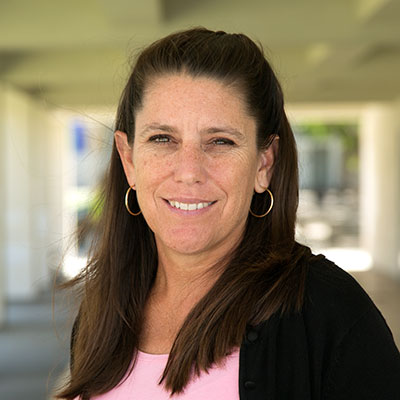
Reflecting on this community-based effort to connect with and support families during the Spring of 2020, Debbie Bailey, the school’s Psychiatric Social Worker and founding teacher shared, “We want to keep this going. I really like that this system came out of a bunch of people because it pulled upon a lot of people’s strengths. It is my hope that I will be at the UCLA Community School for the rest of my career, to really be a part of that community structure, and to really see what community can be if you keep that longevity.”
Part Three: Quantitative Indicators & Dashboards
As the unprecedented access to online school accountability data accelerates, it is especially important to contextualize standardized measures of school quality and progress and use them to drive reflection and improvement. Federal, state, and local agencies oversee the collection of massive amounts of data that are used to create multiple reports and dashboards about the UCLA Community School. For example, the California Department of Education creates the California School Dashboard and a variety of private, non-profit, and partnership organizations produce their own accountability reports, including the Ed-Data Partnership and GreatSchools. Overall, these reports are based on standardized measures and portray the school as below to fairly average and similar to the district as a whole. Conversely, the school was recognized in 2018 by U.S. News and World Report with a Silver Award as the 5th best public high school in LAUSD, 156th in the state, and among the top 1,000 high schools nationally. In 2020, these rankings dropped slightly but the school is still ranked within the top ten traditional high schools in LAUSD. Other honors include a 2019 award from the College Board that recognized the school for “attaining female student representation in AP computer science and helping to close the gender gap in computer science.” While these data are important to reflect upon to drive continual improvement, they do not tell the whole story.
To create a more authentic portrait of the school’s progress, the following four dashboards track quantitative student data related to each of the four core competencies. These data were curated in 2016 to reflect the school’s vision, based on feedback from the school’s Leadership Team and the Research & Accountability Committee of the Shared Governing Council (pictured below). Some measures were chosen to provide local, state, and national comparisons, while others are unique to the school and are tracked over time. Details about each measure are provided at the end of this report. In the fall of 2019, poster-sized versions of the dashboards lined the school quad and were used by Principal Garcia to engage parents in the school improvement process.
Overall, these dashboards portray the school as making steady progress on some indicators and stalled progress on others. The cumulative attendance rate at the school continues to be slightly higher than the district rate. During the school closure in the Spring, online student participation in the middle school was higher than the district average but comparable in the high school. Several indicators were not updated this year, due to the pandemic and elimination of standardized testing and school-based common assessments. Advanced Placement testing was a notable exception and the school continued to outperform the state and the nation on AP Spanish Literature and Culture and AP Spanish Language and Culture. In addition, data from the prior spring reveals that the school tested a much higher proportion of students than the district and state, and passed a slightly higher proportion than the district. Highlights across the dashboards include higher than average or increased responses on several survey items, increasing numbers of students who received Biliteracy Awards, and relatively high rates of graduation, college-going, enrollment, and persistence.
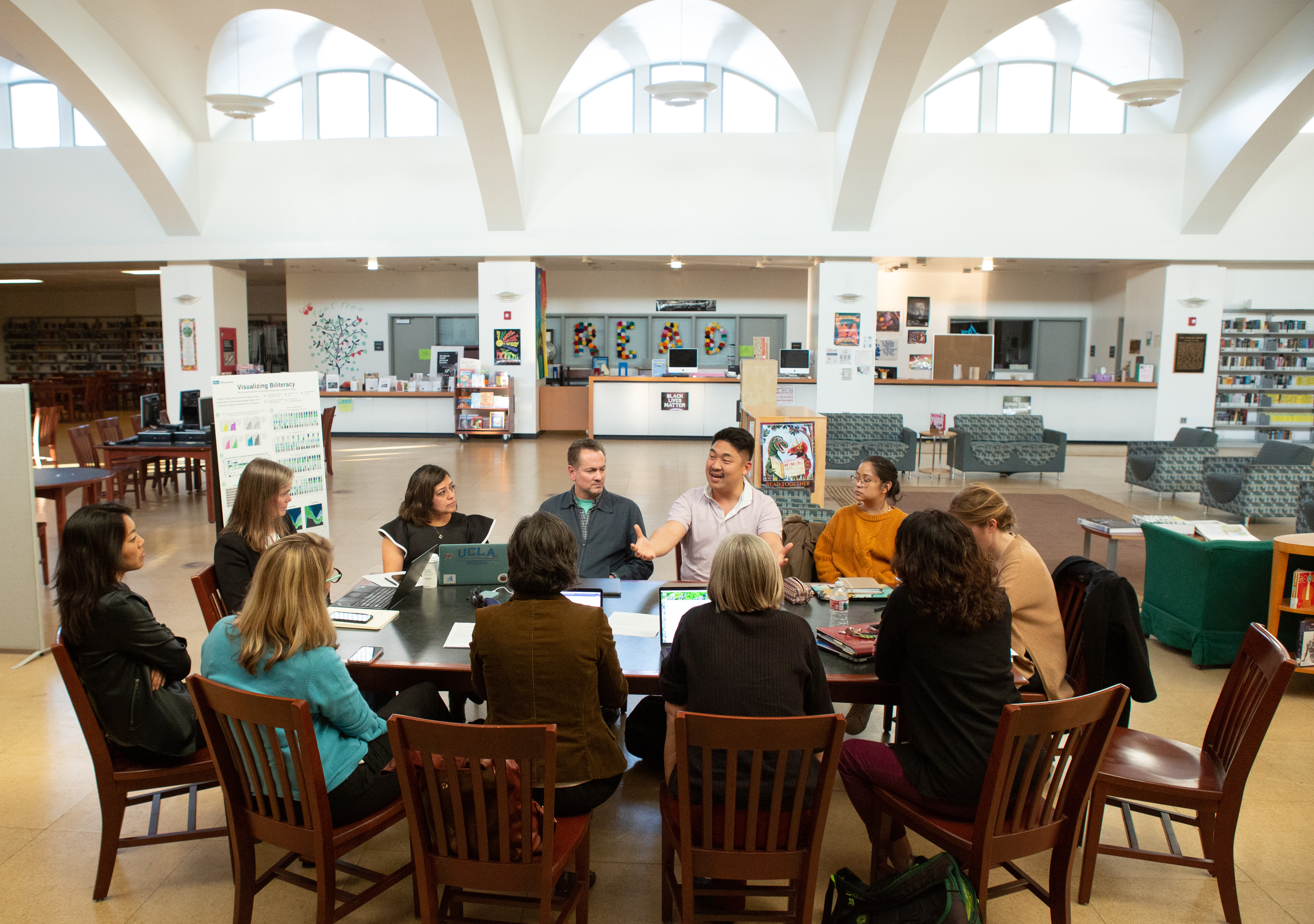
In 2020, an important new indicator was added to the 4CC dashboard: the six-year college completion rate. This is the first year the school has had data to report this rate, based on the postsecondary trajectories of the school’s first four-year cohort of students who graduated in 2014. Given the importance of this indicator to the school-university partnership, data on college persistence and completion are detailed in a forthcoming companion report, Persistent Community: The Challenge of Aligning Supports for First-Generation College-going Students.
Click here to view higher resolution versions of the dashboards.
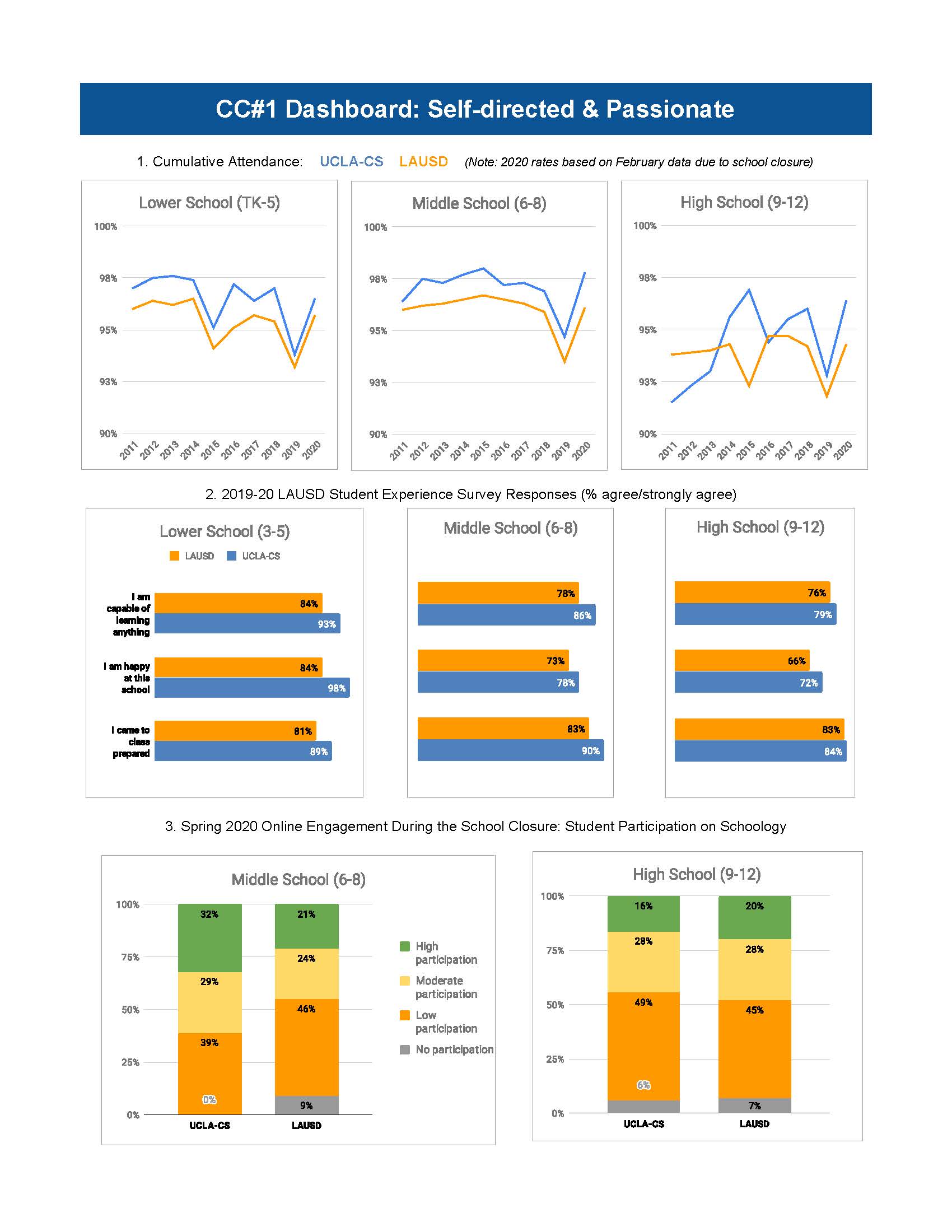
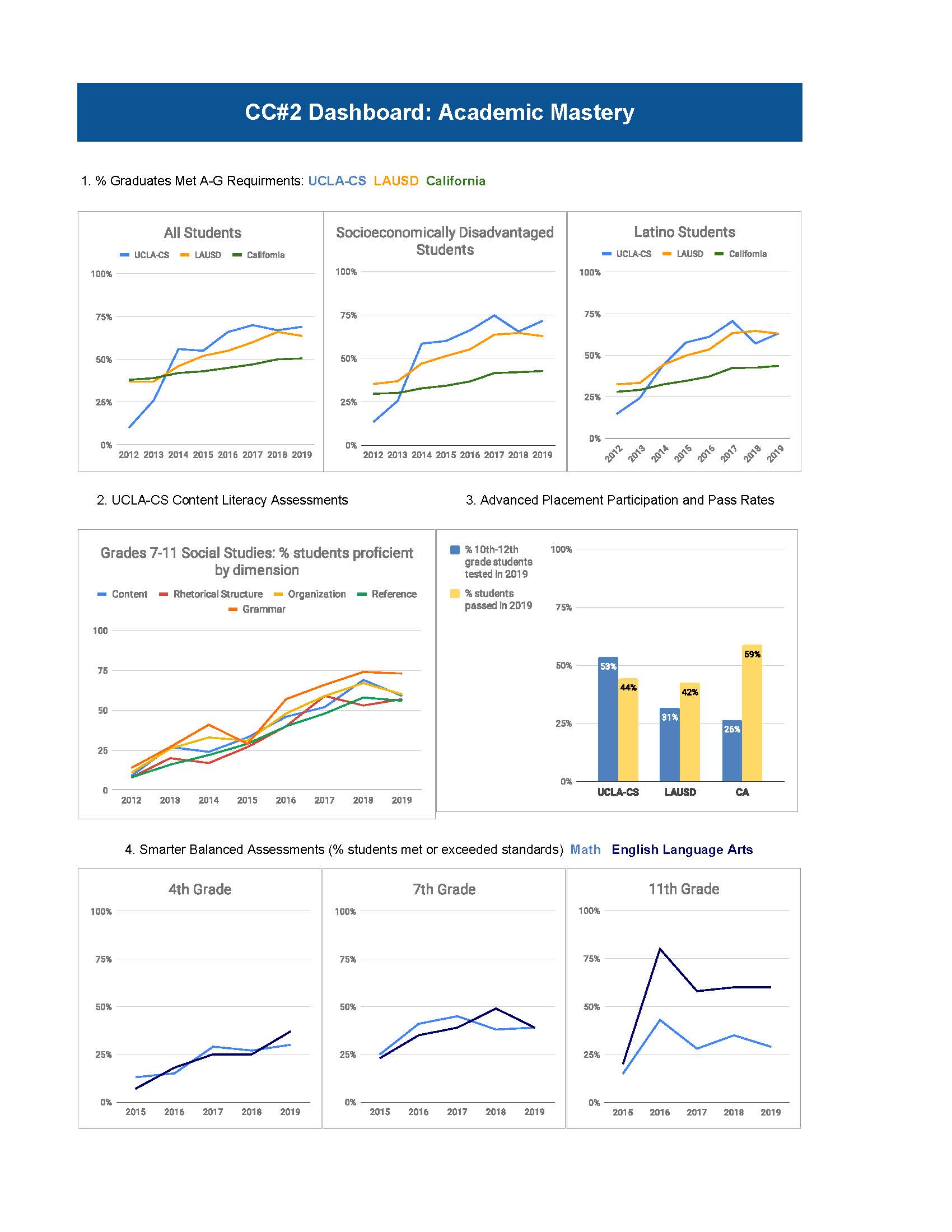

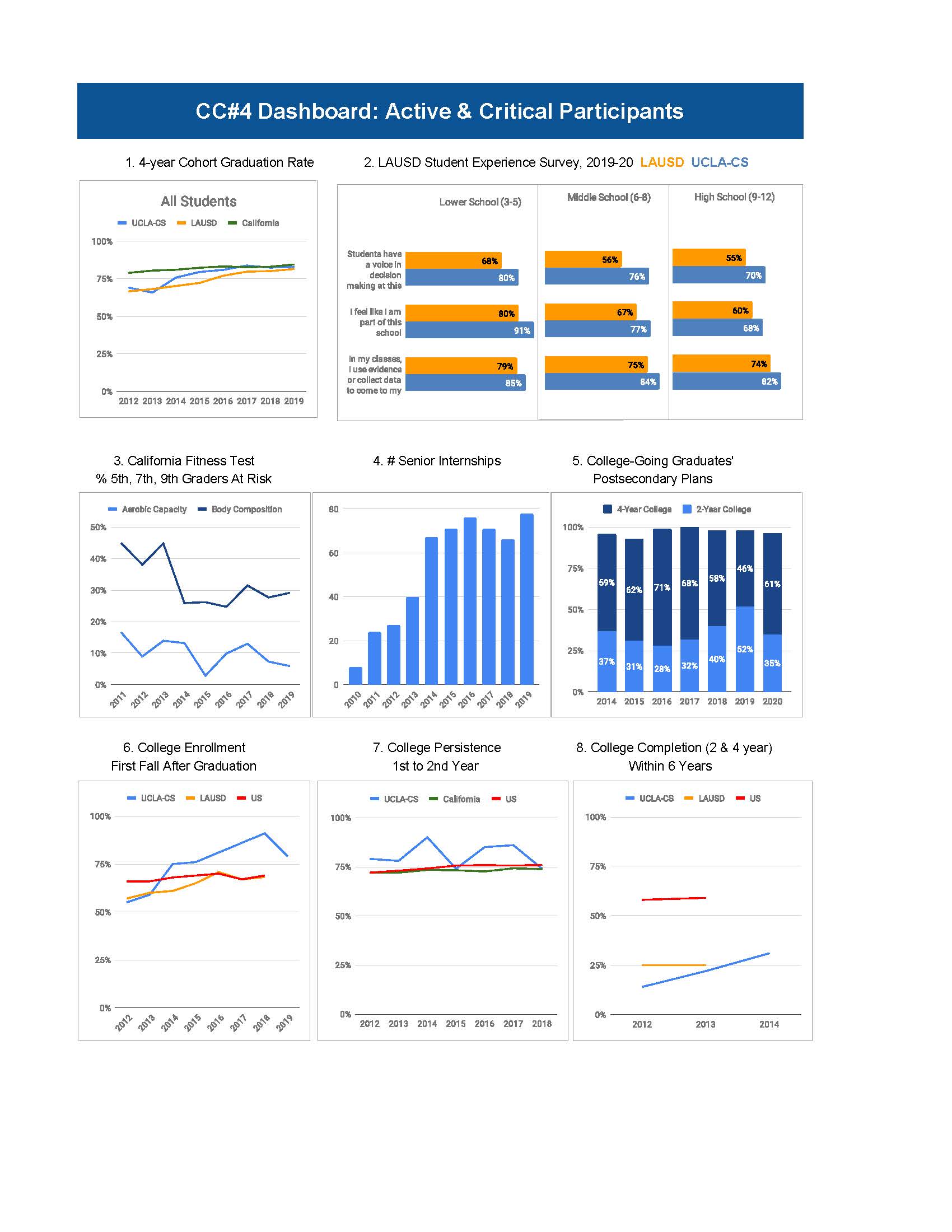
Part Four: Professional Learning & Partnerships
Professional Learning and Working Conditions
To capture the quality of professional learning (PL) at the school, several measures are compiled into a “PL Dashboard.” Overall, these data portray a strong, stable, and professional school culture. Almost all (90-95%) teachers report that the school is a supportive and inviting place to work, promotes trust and collegiality as well as shared decision making–in stark contrast to the district averages of 70-77%. In 2019-20, teachers also reported a slight increase in access to resources such as time, technology and feedback to improve. Other areas of growth include the percentage of teachers who feel they are recognized as educational experts and are able to work in professional learning communities. There was a dip, however, in the percentage of teachers who agree that professional development enhances their ability to improve. Teacher retention continues to be higher than average, with a notable increase in the number of teachers staying in 2019-20. And there was a small uptick in the proportion of educators who report that the workload is sustainable.
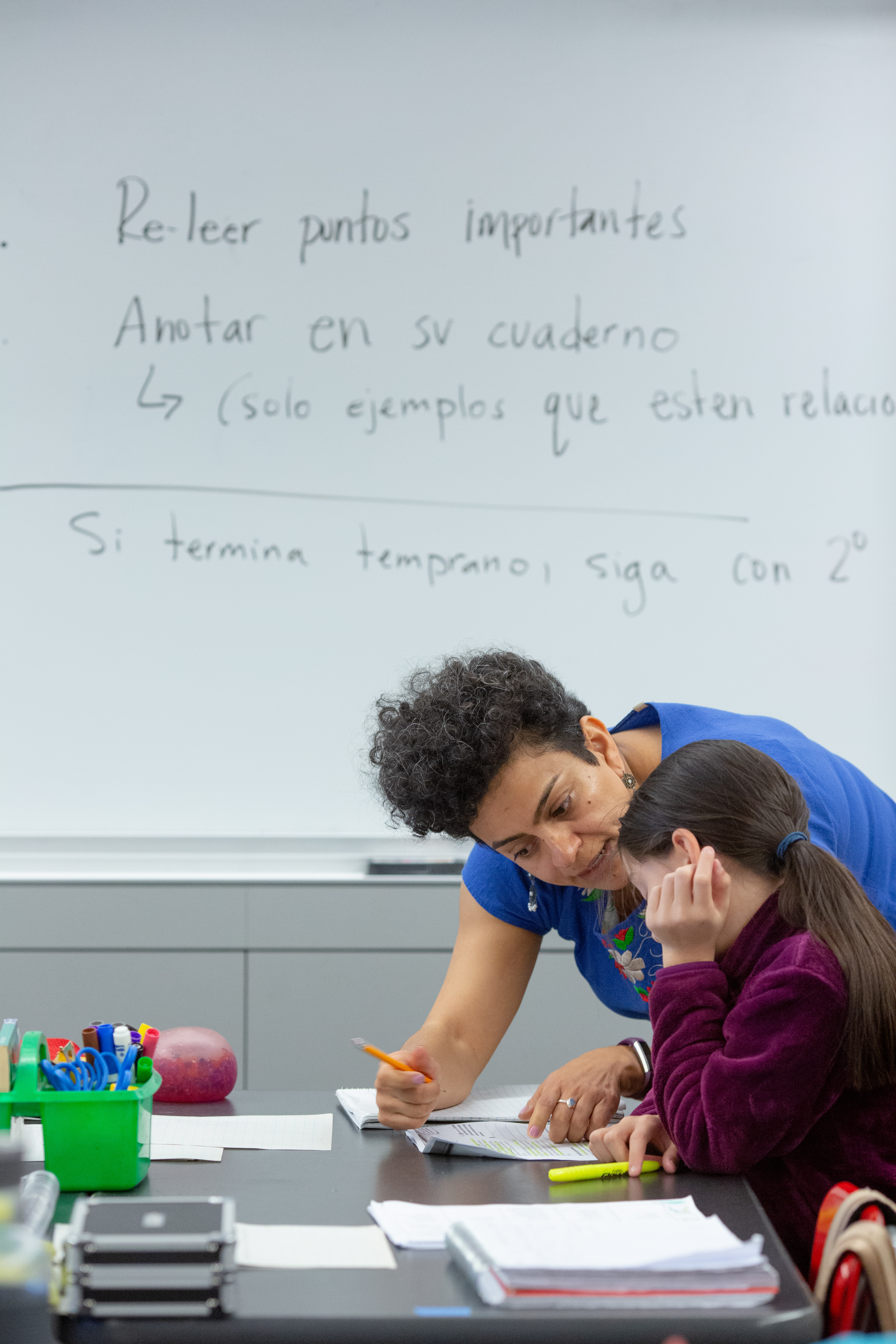
The UCLA Community School was created to be a Teaching School, with a shared commitment to making practice public and modeling excellent teaching for the next generation of educators. As an organization, the school has put in place structures to support collaboration, professional inquiry, and teacher leadership. In 2019-20, 13 UCLA student teachers learned alongside experienced mentor teachers at the school for the entire year and an additional student joined online during the spring closure. Den 3 lead teacher Jackie Belloso (pictured right) also served in 2019-20 as an instructor on bilingual education strategies for UCLA’s Teacher Education Program–bringing her wealth of experience and knowledge on dual language teaching and learning.
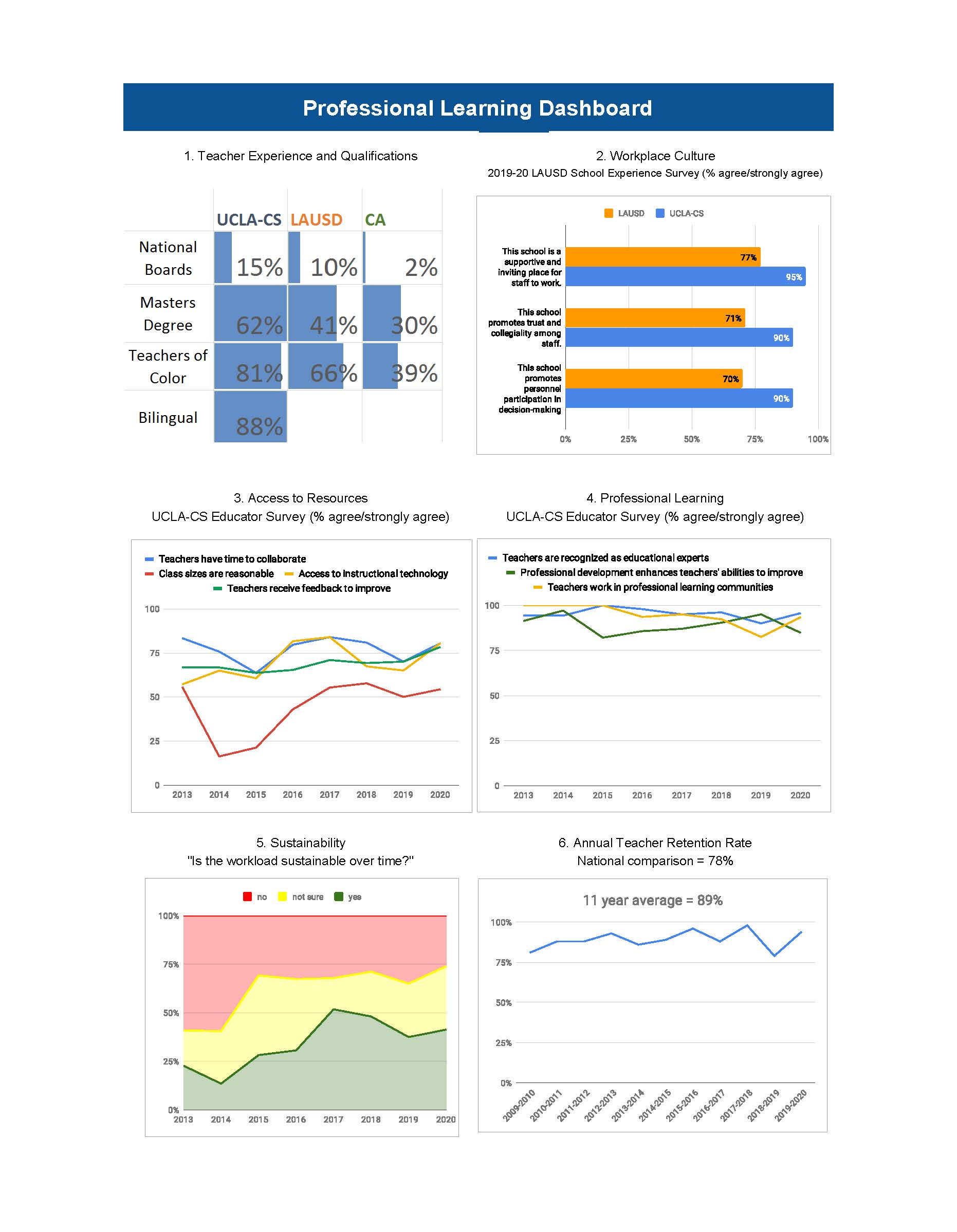
UCLA Partnership
Kicking off the 2019-20 school year, the entire community of students, educators and partners came together on September 9th to celebrate the school’s 10th birthday with UCLA’s signature 8-Clap. As the school’s lead community partner, UCLA faculty, staff, and students engage as researchers, tutors, teaching artists, and more–contributing in 2019-20 a total of 16,040 hours of service. As the UCLA Dashboard describes, this level of participation has been steady since the school opened.
 Extramural grants and gifts further support a variety of initiatives such as the school’s college-going culture, bilingual program articulation, and instructional improvement. For example, in 2019-20, Upper School mathematics teachers joined monthly with educators from other UCLA partner schools to deepen their networked improvement community and professional relationships. Overall, the school continues to be a vibrant site for engaged scholarship and professional learning.
Extramural grants and gifts further support a variety of initiatives such as the school’s college-going culture, bilingual program articulation, and instructional improvement. For example, in 2019-20, Upper School mathematics teachers joined monthly with educators from other UCLA partner schools to deepen their networked improvement community and professional relationships. Overall, the school continues to be a vibrant site for engaged scholarship and professional learning.
Of particular note, the UCLA Immigrant Family Legal Clinic engaged 26 law students in 2019-20 in serving students and families, completing its first full year of operation. As detailed in this story, the clinic is the nation’s first and only immigration law clinic on a K–12 public school campus. Among the clinic’s initial successes, four members of an immigrant family who fled persecution in Mexico were recently granted legal asylum in the United States. Clinic director Nina Rabin also participated in UCLA’s Data for Democracy curriculum project, helping teachers and students learn more about immigration law, DACA, public benefits, and sanctuary schooling.
 Another UCLA partnership highlight in 2020 was facilitated by Rebecca Flynn, who in 2019 transitioned from her role as history teacher at the school to teacher librarian for all six RFK Community Schools. Before teaching at the school, Ms. Flynn was a community organizer and worked alongside John Delloro and other worker’s rights advocates. This experience ignited her interest in a traveling multimedia Artivism exhibit: UCLA’s Our Stories Our Impact. Portraits of Delloro and other activists were on display in February through March 13th when schools closed. Ms. Flynn collaborated with UCLA professors and seven undergraduates to co-plan a series of educational activities to help the entire community learn from this exhibit of UCLA Bruins who have advanced equity and equality in America. After touring the exhibit, K-12 students created their own Artivism portraits of someone they felt made a difference in the world. From family members to activists like Nelson Mandela, the students’ portraits were displayed in the library. Chicano/a Studies Professor Abel Valenzuela ended the class with a unity clap used to build solidarity in social movements.
Another UCLA partnership highlight in 2020 was facilitated by Rebecca Flynn, who in 2019 transitioned from her role as history teacher at the school to teacher librarian for all six RFK Community Schools. Before teaching at the school, Ms. Flynn was a community organizer and worked alongside John Delloro and other worker’s rights advocates. This experience ignited her interest in a traveling multimedia Artivism exhibit: UCLA’s Our Stories Our Impact. Portraits of Delloro and other activists were on display in February through March 13th when schools closed. Ms. Flynn collaborated with UCLA professors and seven undergraduates to co-plan a series of educational activities to help the entire community learn from this exhibit of UCLA Bruins who have advanced equity and equality in America. After touring the exhibit, K-12 students created their own Artivism portraits of someone they felt made a difference in the world. From family members to activists like Nelson Mandela, the students’ portraits were displayed in the library. Chicano/a Studies Professor Abel Valenzuela ended the class with a unity clap used to build solidarity in social movements.
A third partnership highlight was the piloting of a new UCLA undergraduate course, Education 188: Transformative Research in Community-Based Settings. Supported by the Chancellor’s Award for Community-Engaged Scholars, this course was co-developed by UCLA professors, Rashmita Mistry and Karen Hunter Quartz, and UCLA-CS teacher Beth Trinchero and introduces upper-level undergraduates to a range of research-practice partnerships that are ongoing at the UCLA Community School. Students also learn about the school and transformative community-based research by engaging with a class of high school students enrolled in Advanced Placement Research, a course that “allows students to deeply explore an academic topic, problem, issue, or idea of individual interest. Students design, plan, and implement a yearlong investigation to address a research question.” UCLA students learn transformative research methods and skills alongside the high school students as well as serve in the role of “Expert Advisors” to a small group of high school students. Unfortunately, the teaching of this course was cut short due to the March school closures, but it is scheduled to be taught again in the future.
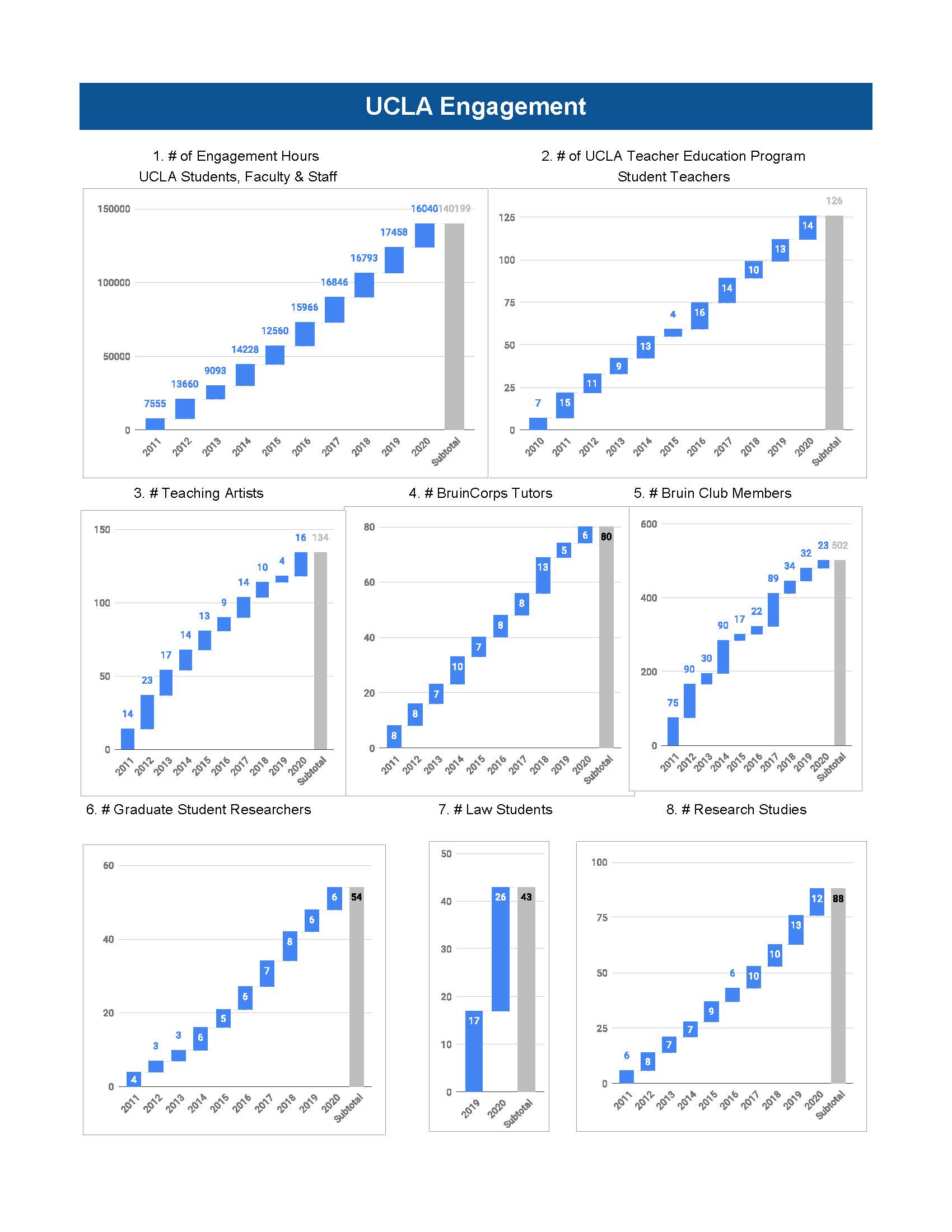
Part Five: Engaging Beyond the School
“LAUSD and UCLA expect the school to develop innovative structures and practices for school governance, staffing, budgeting, assessment, and professional development that will inform school improvement efforts across the district, state, and nation.” This expectation from the original 2010 partnership agreement was realized in many ways throughout 2019-20.
In 2017, the UCLA Center for Community Schooling was established to share the work of the UCLA Community School as well as the new Mann UCLA Community School—joining with others to unite the K-12 community schools movement with higher education civic engagement reforms. The UCLA Community Schools are part of a growing University-assisted Community Schools Network convened by the national Coalition for Community Schools and the University of Pennsylvania’s Netter Center for Community Partnerships—tied deeply to the democratic traditions of collective problem solving and equal educational opportunity (Benson, et al., 2017). With generous support from the Netter Center, the UCLA Center for Community Schooling was named a Regional Training Center for university-assisted community schools in the states of California, Oregon and Washington. In this capacity, the center organizes conferences, gives presentations, hosts study tours, engages in research-practice partnerships, and develops publications and materials to inform the development of community schools.
Study Tours, Conferences and Presentations
The UCLA Community School welcomed 134 visitors from all over the world in 2019-20 and expected to welcome 103 other visitors for Spring study tours that were cancelled due to the pandemic (see Appendix 2 for details). UCLA and school partners shared the work of university-assisted community schools at several professional conferences, including the California School Boards Association, Reimagining Migration, the UCLA Life Course Intervention Research Network, the iCan Children’s Global Summit, and the Rise Up for Equity Virtual Summit. We highlight these last two below.
iCan Children’s Global Summit in Rome
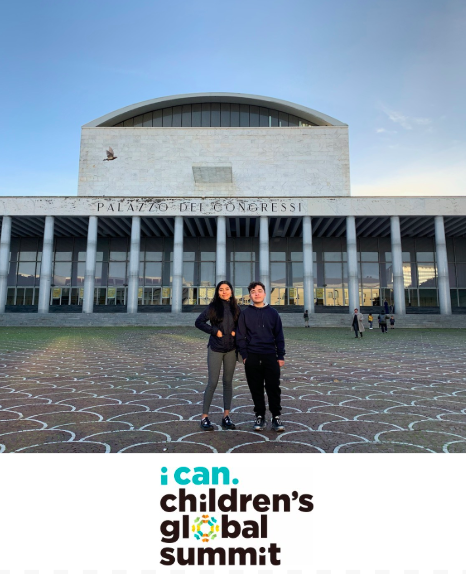 From November 26th-30th, 2019 UCLA Community School students Nyslai and Eduardo joined 4,000 other students from around the world for the I CAN Children’s Global Summit. Youth met to discuss and share ideas for tackling global issues such as peace, climate action, and poverty. Click here to watch Nyslai and Eduardo’s video submission about supporting immigrants.
From November 26th-30th, 2019 UCLA Community School students Nyslai and Eduardo joined 4,000 other students from around the world for the I CAN Children’s Global Summit. Youth met to discuss and share ideas for tackling global issues such as peace, climate action, and poverty. Click here to watch Nyslai and Eduardo’s video submission about supporting immigrants.
On the final day of the conference, students had a live audience with Pope Francis. This extraordinary opportunity was made possible by Dr. Marcelo Suárez-Orozco, Wasserman Dean and Distinguished Professor of Education at the UCLA Graduate School of Education and Information Studies, who welcomed youth to the Summit. Dr. Suárez-Orozco is an Academician of the Pontifical Academy of Social Sciences–a board of appointed members who meet to promote the study and progress of the social, economic, political, and juridical sciences.
2020 Rise Up for Equity Summit on Community Schools and Family Engagement
In the fall of 2018, Center staff began planning for a May 2020 national convening of 5,000 community school practitioners and partners at the LA Convention Center. We joined two other local co-hosts, the Los Angeles Education Partnership and Families in Schools, to help support the national Coalition of Community Schools and Institute for Education Leadership in co-constructing a program of site visits, workshops, and events that would elevate the work of community schools in Los Angeles and showcase the role of higher education partners. A Summit launch on November 4, 2019 set in motion bi-weekly meetings to develop a range of workshops that captured the need for community schools, the experiences of students, families, practitioners and community members in community schools, and community school outcomes. In April, the Summit was moved online due to the pandemic and the program was restructured.
On June 15, 2020, Center staff and graduate students participated in a deep dive session on University-Assisted Community Schools (UACS) that featured 13 school-university partnerships. In preparation, we created a new UACS network website that provides background information, partnership highlights, and research and evaluation efforts. On June 22nd, more than 130 community schools practitioners, district leaders, youth, researchers, and other participants at the Virtual Rise Up for Equity Summit engaged in an hour-session on teaching and learning practices in Los Angeles community Schools. The session featured the work of teacher research fellows, including Nivia Alvarado from Humanitas Academy of Art and Technology, Lorenza Yarnes from Leo Politi Elementary, Darlene Tieu from Mann UCLA Community School, Roberto Vega from Social Justice Humanitas Academy and Rosa Jimenez from UCLA Community School–members of the UCLA Consortium of Community Schools.
Press and Media
The school received notable coverage in the media in 2019-20, including an ABC news segment on alumni and their college journeys and a national photo project to document deeper learning.
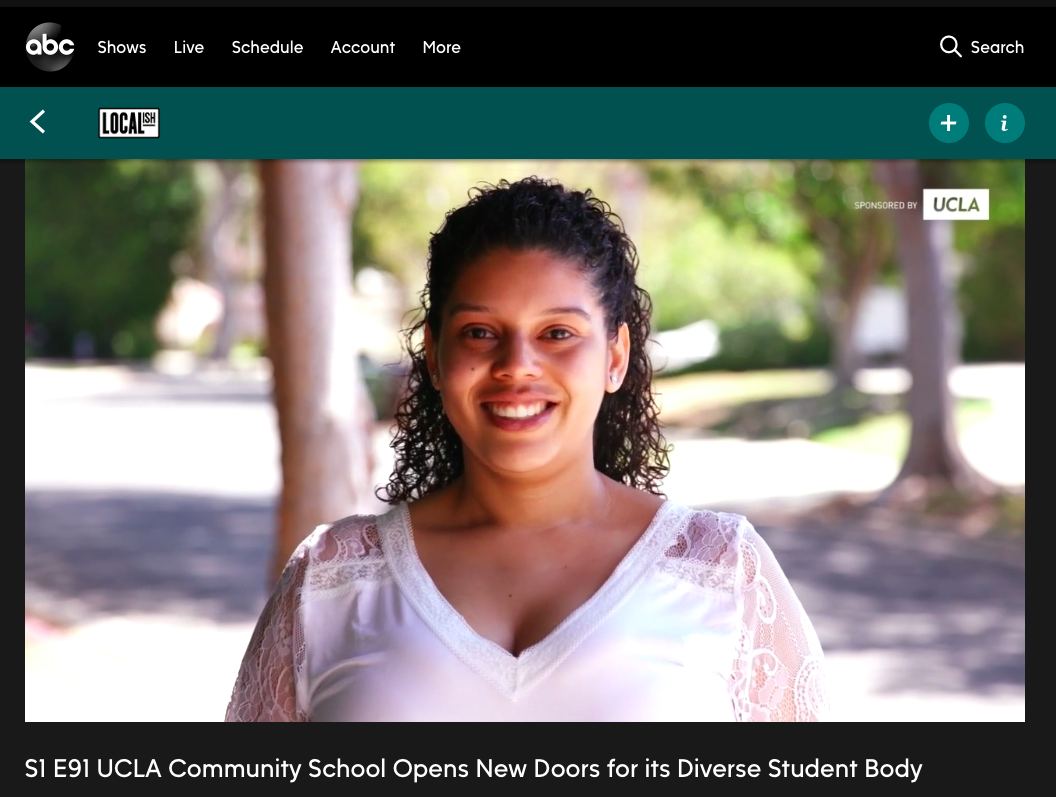
UCLA Community School Alumni Joselyne Franco (pictured above), Brenda Benitez, and Jeffrey Hayes are featured in this video that captures their college going journeys and aspirations for the future. UCLA Newsroom created a companion article detailing the school’s success in preparing first-generation college going students.
The Alliance for Excellent Education (All4Ed) released the second edition of its popular online photo gallery “American Education: Images of Teachers and Students in Action” aimed at demonstrating what deeper learning looks like in the classroom. The 200 new images added to the photo gallery feature teachers and students from UCLA Community School in Los Angeles and Sutton Middle School in Atlanta.
The images were captured by Allison Shelley, a photojournalist based in Washington, DC. Shelley is cofounder of the nonprofit Women Photojournalists of Washington and has worked as director of photography for Education Week and as a staff photographer for The Washington Times. Her photography is regularly featured in publications such as National Geographic, The New York Times, and The Guardian, among others.
In describing her work with All4Ed, Shelley shared, “This collaboration has been a refreshing opportunity to apply my experience with photography in the educational space for an organization that both respects creative teaching and learning, and values nonstaged image making. The deeper learning model engages students and teachers in unique ways, and I am excited to continue to document this approach as it evolves and adapts to meet these challenging times.”
Research-Practice Partnerships
The school continues to be an active site of research, with 12 studies (some ongoing) conducted in 2019-20 on topics including the experiences of newcomer students, transformative parent engagement, the link between student and teacher agency, the development of emergent bilingual students, and the diverse college pathways of first-generation students. Most of these studies are framed as research-practice partnerships or RPPs: “long-term collaborations between practitioners and researchers that are organized to investigate problems of practice and solutions for improving schools and districts” (Coburn, Penuel, & Geil, 2013, p. 48; Quartz, et al., 2017). The school also hosts summer partnership retreats that bring together UCLA and school partners to review research, school data, and develop insights to inform program planning.
Several reports, briefs, conference presentations, research articles, and dissertations on the school’s work were produced in 2019-20. Many of these research-practice artifacts were disseminated on the Center’s website and in monthly newsletters to educators, policymakers, and community leaders. Research-Practice Partnership Reports include:
Translanguaging: A Look Inside a High School Geography Class
Infrastructuring Student Agency: A Research, Practice & Policy Report
The school’s work is also captured in published articles and dissertations, but rarely is the school identified or named, to preserve the confidentiality of research subjects. Three exceptions in 2019-20 include two forthcoming book chapters and an article, “Classroom teachers in the community schools movement: A social justice perspective,” in the AFT’s magazine, American Educator. The first book chapter, entitled “UCLA Community School: Creating a Workplace Culture that Sustains Social Justice Educators” is part of an edited volume on UCLA Center X’s work to prepare and sustain community teachers. The second chapter, entitled, “Sanctuary Schooling: The Norms, Structures, and Practices that Support Immigrant Students,” is a case study of the school’s efforts to support immigrant students and families, and will be included in an edited volume on the intersection between immigration and education policy.
Conclusion
Community schools across the nation are rising up to meet the challenges of the COVID-19 pandemic because they were designed to be, in Horace Mann’s words, “the cornerstone of our community and democracy.” As this report has detailed, the UCLA Community School has systems in place to feed families in need, provide legal support when they are evicted or lose their jobs, and make connections to other social services and resources. The school is also preparing the next generation to rise up against the structural inequality and racism that is causing Black and Latino Californians to die of the coronavirus at disproportionate rates. As it has for more than a decade, the UCLA Community School is preparing students to be active and critical participants in society. Through ongoing research and development, school and UCLA partners continue to refine the school’s instructional program and strengthen its trusting and inclusive culture. This commitment to sustained inquiry and collaboration defines the UCLA Community School and has allowed it to adapt and respond to the global pandemic and the many challenges of online learning. By recognizing and honoring the power and needs of the entire community, the school continues to grow together during these extraordinary times.
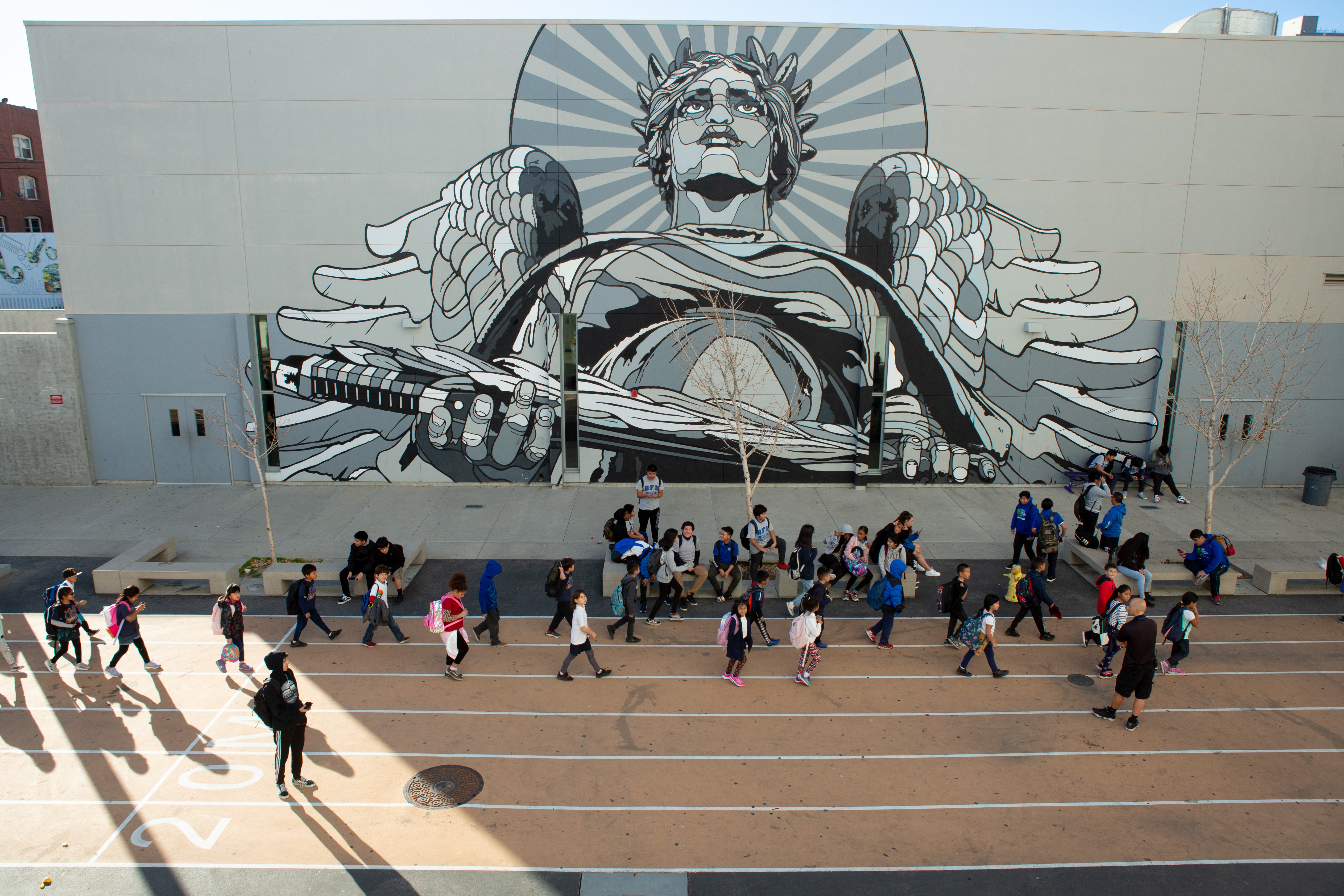
About the Data
Figures and Tables
Figure 1: Data on race/ethnicity was retrieved from California State Department of Education (http://dq.cde.ca.gov/dataquest/) in August 2020. It should be noted that these identity labels do not necessarily capture the way students identify themselves.
Table 1: Data on student groups was retrieved from California State Department of Education (http://dq.cde.ca.gov/dataquest/) in August 2020.
Figure 2: Data on race/ethnicity was retrieved from California State Department of Education (http://dq.cde.ca.gov/dataquest/) in August 2020. It should be noted that these data are based on the prior school year and the identity labels do not necessarily capture the way teachers identify themselves.
Figure 4: Data collected by the school in the Spring of 2020 through teacher check-ins with students and student surveys.
Dashboards
CC#1 Dashboard
- Cumulative Attendance: LAUSD data retrieved from My Data in August 2020 using grade span comparisons based on June cumulative attendance for 2011-2019 and February cumulative attendance for 2020 due to the school closure.
- Student Engagement Survey Responses: LAUSD data retrieved in August 2020 from 2019-20 school experience survey reports.
- Spring 2020 Online Engagement: LAUSD data prepared by the Independent Analysis Unit, see Besecker & Thomas (2020) for more information.
CC#2 Dashboard
- Percentage of Graduates Met A-G Requirements: California State Department of Education data retrieved from Dataquest in August 2020.
- UCLA-CS Content Literacy Assessments: Developed in partnership with UCLA’s National Center for Educational Standards and Student Testing (CRESST), these assessments were part of a larger-scale research and development effort to create and implement of literacy assessments and supports for middle and high school teachers aligned with the CCSS in reading and writing. These Integrated Learning Assessments (ILAs) were designed to measure both students’ literacy development relative to the CCSS in English Language Arts and depth of content understanding. The Social Studies/History assessments have the following structure: students first read several texts that typify those encountered in the discipline and address important content; students then respond to reading comprehension and analysis questions that are aligned with the CCSS in ELA. Finally, students respond to an essay prompt that, consistent with the CCSS, asks them to synthesize what they know with what they have read to produce an extended explanation or argument about the topic. For more information on the assessment development process, see Quartz, Phelan & Garcia (2016). Scores are reported over time as the percentage of students tested who scored proficient (a 3 or a 4) on each dimension.
- Advanced Placement Participation and Pass Rates: California State Department of Education data retrieved from Dataquest in August 2020.
- Smarter Balanced Assessments: LAUSD data were retrieved from My Data in August 2019.
CC#3 Dashboard
- Independent Reading Levels: Since 2009, UCLA-CS teachers have used the Fountas and Pinnell Benchmark Reading Assessment system to assess Independent Reading Level (IRL) at the Lower School at two different time points each year (Fall and Spring) to evaluate where students fall along the reading continuum in two languages (Spanish and English). This system allows teachers to score student fluency, decoding, and reading comprehension on a developmental continuum that ranges from A to Z. The literacy continuum is used to: (1) provide a foundation for teaching; (2) guide curriculum planning; (3) link assessment to instruction; (4) evaluate and grade; (5) report to parents; and (6) guide intervention. The data presented on the dashboard are Spring, end of year, data. The Research and Accountability Committee developed five proficiency levels to capture progress towards dual proficiency after reviewing research on change and stability of dual language profiles in the early school years (Collins et al., 2012; Hammer, Jia, & Uchikoshi, 2011). The five levels are defined as follows:
- Dual Proficient: reading at or above reading level in both Spanish and English.
- Approaching Dual Proficient: reading at, above or are approaching reading proficiency in Spanish or English, while also approaching proficiency with the second language.
- Monolingual Proficient: reading at or above, reading proficiency in one language; and if reading a second language, the second language proficiency is at least two proficiency levels lower than the dominant language—at “below” proficiency [e.g., English “at”; Spanish “Below.”
- Approaching Monolingual Proficient: approaching reading proficiency in one language.
- Below Proficient: reading below reading level in both languages.
- AP Spanish Literature and Culture: Percentage of students who passed the exam with a “3” or higher. School data is based on the reports provided to the school by the College Board. State and National data was retrieved in August 2020 from the College Board website.
- Reclassification Rates: LAUSD data were retrieved from My Data in August 2020.
- Upper School Reported Language Proficiency: Percentage of students in Grades 7-12 who reported their language use on an annual Upper School Student Survey created and administered by the school each spring.
- Opportunities for Biliteracy: Percentage of students in Grades 7-12 who reported using Spanish in classes other than Spanish on an annual Upper School Student Survey created and administered by the school each spring.
- AP Spanish Language: Percentage of students who passed the exam with a “3” or higher. School data is based on the reports provided to the school by the College Board. State and National data was retrieved in August 2020 from the College Board website.
- LAUSD Biliteracy Awards: The Pathway to Biliteracy and the Seal of Biliteracy Awards, known collectively as the LAUSD Biliteracy Awards, are awarded annually to LAUSD students (in grades 5, 8, and 12) who demonstrate excellence in English and in a language other than English. The number of UCLA-CS students earning these awards is collected and reported by the school.
- California Seal of Biliteracy: The State Seal of Biliteracy (SSB), per Assembly Bill 815 (Brownley, Chapter 618, Statutes of 2011), became effective January 1, 2012. This program recognizes high school graduates who have attained a high level of proficiency in speaking, reading, and writing one or more languages in addition to English. The percentage of UCLA-CS graduates earning the Seal is collected and reported by the school. District and state comparison data were retrieved from Dataquest.
CC#4 Dashboard
- Four-year Cohort Graduation Rate: California State Department of Education data retrieved from Dataquest in August 2020.
- Student Engagement Survey Responses: LAUSD data retrieved in August 2020 from 2019-20 school experience survey reports.
- California Fitness Test: California State Department of Education data retrieved from Dataquest in August 2020.
- Number of Senior Internships: Based on number of students enrolled in Applied Economics class in 12th grade plus the number of seniors who completed summer internships. Note that no students completed internships during the Summer of 2020 due to the pandemic.
- College-going Graduates’ Postsecondary Plans: Data collected by the College Counselor each Spring and stored in a longitudinal database maintained by UCLA. The data is based on confirmation of students’ Statement of Intent to Register (SIR) at a 4-year college on June 1st or students’ application to and report of intention to enroll in a 2-year college.
- College Enrollment: National comparison data on immediate college enrollment during the fall after high school are from the National Center on Educational Statistics. District comparison data on immediate college enrollment are from the National Student Clearinghouse (NSC). For the Classes of 2014 through 2019, the school data are based on NSC records and follow-ups with UCLA-CS alumni, teachers, and counselors. For the Classes of 2012 and 2013, only NSC records were available. Because the NSC may be unable to track all students, especially those who lack legal documentation, the college enrollment numbers for these cohorts may be under reported.
- College Persistence: National comparison data on students who were enrolled in the first year after graduating from high school and returned in the fall of the second year are based on the NSC Report on Persistence and Retention. The same data collection strategies at the school were used to measure enrollment and persistence (see measure 6 for details.)
- College Completion (2 & 4 year) Within 6 Years: National comparison data on college completion are from the NSC Completing College Report. District comparison data on college completion are from the NSC. For the Classes of 2012 and 2013, only NSC records were available. For Class of 2014, the same data collection strategies were used to measure college completion (see measure 6 for details).
PL Dashboard
- Teacher Experience and Qualifications: California State Department of Education data retrieved from Dataquest in August 2020. The percentage of teachers who are bilingual is based on self-reported data collected in an annual Educator Survey at the school each spring.
- Workplace Culture: LAUSD data retrieved in August 2020 from school experience survey reports.
- Access to Resources: Data collected by the school in the annual Educator Survey; these workplace items are based on the North Carolina Teaching Conditions Survey.
- Professional Learning: Data collected by the school in the annual Educator Survey.
- Sustainability: Data collected by the school in the annual Educator Survey.
- Annual Teacher Retention: Data collected and maintained by UCLA based on school faculty rosters. National comparison data for urban, high-poverty schools based on Ingersoll (2004).
UCLA Dashboard
All UCLA engagement data are collected by UCLA staff working at the school using a variety of methods and sources, including sign-in sheets, administrative records, and surveys. Data on research studies are collected using an online research review system maintained by UCLA.
2019-20 Study Tours
| Date | Group | # participants
|
Purpose |
| 9/20/19 | California Partnership for the Future of Learning
|
25 | Education and community leaders convened by the Learning Policy Institute for a full-day study tour of UCLA Community School, organized around the four community school pillars. |
| 9/25/19 | Children’s Institute | 6 | Study tour and meeting with local community-based organization to discuss the integration of social supports and research. |
| 10/10/19 | Argentina Ministry of Education | 75 | Part of the UCLA Graduate School of Education & Information Studies’ International Partnership Program; half-day site visit to the school was part of a three-week intensive program. Read more about the program here. |
| 2/14/20 | Life Course Interventions Research Network/UCLA Medical School | 8 | Study tour and meeting with representatives of the LCI-RN (a project of UCLA’s Center for Healthier Children, Families and Communities). Meeting focused integrated student supports, data systems, and research. Read more about the network here. |
| 2/18/20 | Chancellor’s Cohort of Community- engaged Scholars | 15 | Study tour and meeting of UCLA faculty and community partners funded to develop community-engaged undergraduate research courses. |
| 2/21/20
|
Los Angeles Unified School District
|
5 | Study tour and meeting with LAUSD administrative leaders representing the Office of Civic Engagement, Health and Human Services, and Curriculum and Instruction to discuss LAUSD’s Community School Initiative. |
| 3/10/20 | University Teacher Education Consortium | 33 | UTEC is dedicated to the development of strong teacher preparation programs across the country. The UCLA Teacher Ed Program hosted UTEC’s annual convening this year and aimed to highlight the work of the UCLA-CS and Mann as teaching sites. STUDY TOUR CANCELLED DUE TO COVID-19. |
| 3/12/20 | Association for Supervision and Curriculum Development | 30 | RFK Community Schools selected as site for a visit as part of ASCD’s annual conference. Community partnerships, including the work of the UCLA Center for Community Schooling, to be featured. STUDY TOUR CANCELLED DUE TO COVID-19. |
| 5/20/20 | 2020 Rise Up for Equity Summit | 40 | The UCLA Community School was selected as a study tour site for this national conference. STUDY TOUR CANCELLED DUE TO COVID-19. |
References
Besecker, M. & Thomas, A. (2020). Student engagement online during school facilities closures: An analysis of L.A. Unified secondary students’ Schoology activity from March 16 to May 22, 2020. Independent Analysis Unit. Los Angeles Unified School District.
Coburn, C. E., Penuel, W. R., & Geil, K. E. (2013). Research-practice partnerships: A strategy for leveraging research for educational improvement in school districts. New York, NY: William T. Grant Foundation.
Collins, B. A., O’Connor, E. E., Suarez-Orozco, C., Nieto-Castanon, A., & Toppelberg, C. O. (2012). Dual language profiles of Latino children of immigrants: Stability and change over the early school years. Applied psycholinguistics, 35, 581-620
Harkavy, I., Benson, L., Hartley, M., Hodges, R. A., & Puckett, J. (2017). Knowledge for social change: Bacon, Dewey, and the revolutionary transformation of research universities in the twenty-first century. Temple University Press.
Hammer, C. S., Jia, G., & Uchikoshi, Y. (2011). Language and literacy development of dual language learners growing up in the United States: A call for research. Child Development Perspectives, 5(1), 4-9.
Ingersoll, R. M. (2004). Why do high-poverty schools have difficulty staffing their classrooms with qualified teachers? Center for American Progress, Institute for America’s Future.
Quartz, K.H., Phelan, J., & Garcia, L. (2016). Seizing local freedom to assess: A five-year researcher-practitioner collaboration to create and use performance assessments. Paper presented at the Annual Meeting of the American Educational Research Association, Washington DC, April 2016.
Quartz, K. H., Weinstein, R. S., Kaufman, G., Levine, H., Mehan, H., Pollock, M., Priselac, J., Worrell, F. C. (2017). University-partnered new school designs: Fertile ground for research–practice partnerships. Educational Researcher, 46(3), 143-146.
[print-me]


